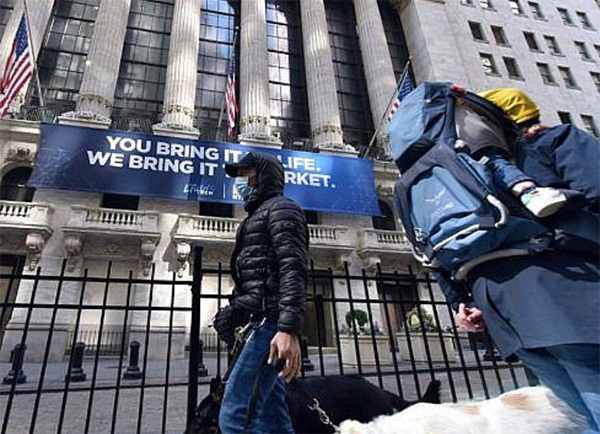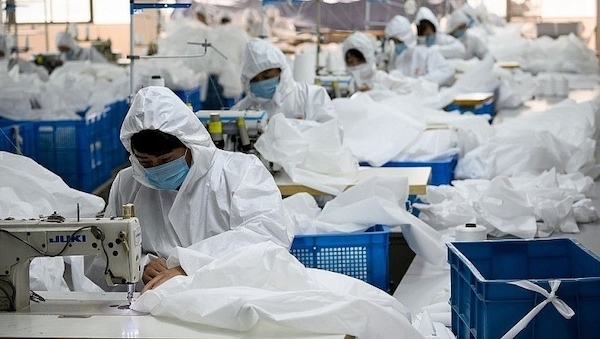 |
|
Without "preparedness", it is likely that the United States will be much more passive and vulnerable to the effects of the current Covid-19 pandemic.
|
Obviously, if the level of binding and globalization is not as high and tight as today, the coronavirus would not have had the opportunity to spread quickly and paralyze the whole world in such a short time.
Therefore, it is not difficult to predict that right after the end of the pandemic, the United States, Japan, the EU and many Western countries in the G20 will make and impose a series of drastic decisions on the operations of big conglomerates, and control of citizens and their behavior, in order to minimize the spread of similar epidemics, as well as unpredictable economic and security impacts in the future.
That will have a profound impact on changing our perceptions of the "new globalization scenario 2.0," including the coming of the biggest wave of displacement, rearrangement with the fastest speed in the world in the fields of investment, production, trade, supply, logistics, services ... ie the factors that constitute the "chain economy" of the current globalization 1.0.
Accordingly, globalization 2.0 has a new connotation, a new form that all countries, whether they like it or not, are forced to find a way to adapt.
Globalization, in its simplest terms, is the process of going forward and integrating into the outside world of people and nations on a global scale. In this way, globalization is not something new, but the process of expressing the desire to reach out and integrate with other people and nations for thousands of years.
In the capitalist era, with science and technology in hand, huge financial resources plus the motivation to seek maximum profits... multinational companies found all ways to expand markets and control resources around the world. Therefore, globalization in some way has been associated with the name "Americanization" or "capitalization."
However, in the last three decades, globalization has a strong momentum of development thanks to two main factors. Firstly, it is China's strong rise after the successful reform and opening process, and its active participation in the integration process into the world, as a major factory and a trade powerhouse in the world. Many people, many countries look at China with anxiety, lack of sympathy, they even assign the name of globalization to the process of "Chinazation of the world".
Secondly, the rapid advances in transportation, science and technology, especially aviation and information technology, over the past two or three decades have promoted human cohesion, the circulation of goods and services ... on an unprecedented level and created a world interdependently and more connected than ever before.
It is undeniable that globalization has brought many positive changes to most countries participating in this process as:
(i) Billions of people around the world have escaped poverty from joining and becoming a link in the global chain economy, global production, supply and service chains.
(ii) A number of countries, typically China and countries in East Asia, created miraculous development and quickly closed the development gap with the leading industrial countries in the world.
(iii) Thanks to global competition, inventions and improvements are constantly being introduced and applied, and the lives of people around the world are greatly improved by benefiting from the acquisition of useful products with good quality at affordable prices.
(iv) Many useful global values such as democracy, human rights, gender equality, green and sustainable development, anti-climate change ... have become popular and become an essential part of the life.
However, besides the positive side, globalization is also considered to cause many negative aspects such as:
(i) Create new poverty and impoverishment. People in many countries no longer suffer from food shortages but they face increasing difficulties in having access to equal opportunities in health, education, social welfare and income.
The gap between the rich and the poor within a country and in the world is increasingly clear when less than 1% of the richest people in the world control over 90% of the wealth of society.
(ii) Globalization also results in an unequal division of labor in the international division of labor, in which developing countries are now in the position of cheap raw materials and fuel suppliers, the consumption market, and places to suffer from environmental pollution and the devastation of climate change.
(iii) Globalization does not help create a global governance mechanism, help forecast, or mitigate, the impact of global disasters, such as the Covid-19 epidemic today.
It was not until the Covid-19 pandemic appeared that the new administration of President Donald Trump saw the "loss" of the US in the globalization race and had "struck fatal blows" on globalization shortly after coming to power in early 2017.
Spurred by the United States and the West, now "globalization 1.0" is considered "obsolete" by the United States as it has fulfilled its "historic mission" and is no longer in service or in accordance with American and Western interests.
The US argued that China is now a country that is making good use of and "taking advantage" of the gaps of globalization to strengthen its national strength and seek to rise beyond the United States to become the world's number one power.
 |
|
Workers wear protective gear and masks at a Chinese factory. (Source: Market Watch)
|
Trump unilaterally launched a trade war against China, and sought to negotiate and re-sign a series of new bilateral and multilateral trade agreements. The US-China trade war under the influence of Trump's new trade and economic policy has created initial but extremely powerful shifts in positioning and rearranging the "chain economy", which forced many American and foreign businesses to withdraw from the Chinese market to diversify their investments to avoid being taxed and to minimize the risk of putting all their eggs in one basket.
Without "preparedness", it is likely that the United States will be much more passive and vulnerable to the effects of the current Covid-19 pandemic. Some changes of globalization in the "post-Covid-19" period are anticipated as follows:
- The general trend is not to give up, but "linkages" and "integration" will be conducted cautiously and in a controlled manner by nations.
- The trend of "non-China", ie "escaping", or minimizing dependence on a dominant market or partner like China, is likely to be promoted, with the leading economies like the US, Japan, Germany ... pioneering this trend.
The second largest market in the world with 1.4 billion "customers" like China is an irresistible attraction for any company or country. Therefore, putting all eggs in one basket is understandable. However, due to its heavy dependence, when China "sneezed" due to the Covid-19 impact, the whole world became "breathless". For example, China supplies up to 90% of raw materials for making antibiotics.
Instead of "outsourcing", the new term that the US now begins to use is "expensing", meaning the US government is willing to pay 100% of the cost for US companies to leave China and transfer production to the US or to other countries.
The US government has prepared the money and was ready to "open the purse" to implement this plan immediately after the Covid-19 pandemic. Following the US, Japan also envisaged a budget of about $2 billion to support Japanese companies to withdraw from China and bring their factories to other countries.
Once the "Chimerica" marriage worth $2,000 billion comes to an end with a "divorce", nothing is impossible.
- The formation of a new "chain economy" will have the following characteristics:
(i) Policymakers now have a new mission: planning for self-sufficiency so that their country can survive in a state of complete isolation from three months to three years.
(ii) Countries will race, find ways to produce or build stockpiles of essential medical goods and strategic commodities, regardless of the supply of other countries.
(iii) The approach is to "not to put all the eggs in one basket", but to maximize the sources of production, the source of supply of raw materials and consumption markets, of which the domestic market is given priority.
- The trend of diversifying and shifting investment and production out of China also means that it will form a wave of shifting investment to emerging economies in Southeast Asia and some other regions.
Countries like Vietnam need to see opportunities soon, to not only prepare for the immediate recovery of production, but also to grasp this new trend of investment shift of the world.
Hoang Anh Tuan

The world in the post-Covid-19 era (Part 2)
Some questions must be answered clearly: Where and in what context did Covid-19 appear? Were the World Health Organization's (WHO) detection and warnings timely enough in preventing the pandemic outbreak?

The world in the post-Covid-19 era
The coronavirus pandemic has not passed, but it has been and will leave severe consequences in all aspects of human life, as well as international relations.
 Originally regarded as a "savior", the Covid-19 pandemic has created new skepticism, considering globalization as a "criminal" that spread the coronavirus epidemic across the globe and caused the current disaster.
Originally regarded as a "savior", the Covid-19 pandemic has created new skepticism, considering globalization as a "criminal" that spread the coronavirus epidemic across the globe and caused the current disaster.